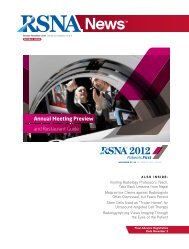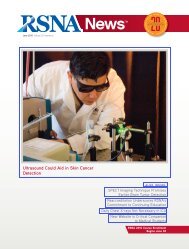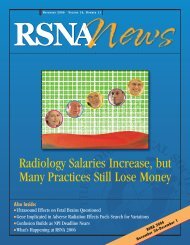RSNA 2009 Meeting Preview - Radiological Society of North America
RSNA 2009 Meeting Preview - Radiological Society of North America
RSNA 2009 Meeting Preview - Radiological Society of North America
You also want an ePaper? Increase the reach of your titles
YUMPU automatically turns print PDFs into web optimized ePapers that Google loves.
tects and vendors to improve lighting<br />
and workflow and reduce noise, said<br />
Dr. Horii, who will discuss the topic in<br />
depth at <strong>RSNA</strong> <strong>2009</strong>. He and Rostenberg<br />
will also discuss regulatory issues<br />
impacting radiology architecture.<br />
Design Shifts from Radiology-Centric Areas<br />
Overall facility design is another area<br />
ripe for optimization, said Dr. Horii.<br />
“We need to get away from radiologycentric<br />
areas,” he said. “When a doctor<br />
has to wander around the hospital for<br />
10 minutes searching for a consulting<br />
radiologist, that’s too time-consuming.”<br />
Location makes a difference when<br />
it comes to patients as well. Despite<br />
all the advancements that have come<br />
with PACS, patients must still go to the<br />
equipment, which can be time-consuming.<br />
If a CT scanner is 300 feet from an<br />
elevator, it takes longer for the patient<br />
to get to and from the scanner and on<br />
and <strong>of</strong>f the table than it does to take an<br />
image.<br />
Such considerations are particularly<br />
key in this age <strong>of</strong> healthcare reform,<br />
Dr. Horii said, as the utilization <strong>of</strong><br />
equipment must increase dramatically.<br />
“Hospital administrators and the government<br />
seeking a 90 percent utilization<br />
rate on a million-dollar piece <strong>of</strong><br />
imaging equipment should know that it<br />
is going to be very difficult with inefficient<br />
room turnover,” he said.<br />
That is one reason architects strive<br />
to bring equipment design in sync with<br />
the design process, said William N.<br />
Bernstein, A.I.A., a principal with the<br />
New York-based firm Architecture for<br />
Radiology, whose members regularly<br />
attend <strong>RSNA</strong> annual meetings.<br />
“Clients <strong>of</strong>ten delay the final equipment<br />
selection until the very end <strong>of</strong> the<br />
process in order to keep options open<br />
and, in some cases, reduce costs,” said<br />
Bernstein. “That creates an issue on the<br />
design end when final equipment specs<br />
are needed sooner. One way <strong>of</strong> dealing<br />
with this is designing ‘universal rooms’<br />
that allow physicians greater flexibility<br />
and more time to make their final<br />
equipment selection.”<br />
Bernstein said radiology architects<br />
ensure that the infrastructure supports<br />
the equipment and that architects who<br />
are trained to understand the needs<br />
<strong>of</strong> radiology learn to ask, “When the<br />
equipment needs to be replaced in the<br />
future, what is the exit path?”<br />
Dr. Horii said that exit path is<br />
sometimes forgotten until it’s too late.<br />
“When an MR is built in the center <strong>of</strong><br />
a facility, how are you going to get the<br />
giant magnets out when it’s time to<br />
upgrade?” he asked.<br />
He cited one hospital that initially<br />
broke into the side <strong>of</strong> a building to<br />
bring the magnet inside. Years later,<br />
another building went up next door.<br />
Intraoperative MR Imaging<br />
Perhaps the most complex example <strong>of</strong> surgical and<br />
imaging convergence, intraoperative MR imaging (I-MRI)<br />
provides image guidance during surgery. I-MRI facility<br />
design requires a unique understanding <strong>of</strong> MR imaging<br />
safety criteria as well as surgical protocol for clinical<br />
workflow. In this example, the magnet is mounted on a<br />
track that allows the I-MRI to move from the diagnostic<br />
area into the operating room and then back into the diagnostic<br />
suite for surgery to continue.<br />
Image courtesy <strong>of</strong> ANSHEN+ALLEN<br />
When it was time to upgrade the MR,<br />
the magnet had to be broken apart in<br />
order to remove it, which was very<br />
costly.<br />
Value <strong>of</strong> Radiology Architecture Not Fully<br />
Understood<br />
“Many radiology pr<strong>of</strong>essionals don’t<br />
have a good sense <strong>of</strong> what architects<br />
do,” said Bernstein. “There is a huge<br />
value in what a properly trained radiology<br />
architect can do in terms <strong>of</strong><br />
framework design, construction, getting<br />
equipment in place, the aesthetics <strong>of</strong><br />
the project and ultimately, the success<br />
<strong>of</strong> the business.”<br />
“We put a great deal <strong>of</strong> emphasis<br />
on what the space feels like for the<br />
patient, staff and faculty,” said Rostenberg.<br />
“That is extremely important.” ■<br />
❚<br />
Architecture at<br />
<strong>RSNA</strong> <strong>2009</strong><br />
The multisession course, “Architecture That<br />
Makes a Difference: Design Guidelines for<br />
Tomorrow’s Imaging<br />
Environment,” will<br />
be held on Monday,<br />
Nov. 30, at <strong>RSNA</strong><br />
<strong>2009</strong>.<br />
Registration for<br />
this and all <strong>RSNA</strong> <strong>2009</strong> courses is under<br />
way at <strong>RSNA</strong><strong>2009</strong>.<strong>RSNA</strong>.org.<br />
<strong>RSNA</strong>NEWS. ORG<br />
<strong>RSNA</strong> NEWS<br />
9






